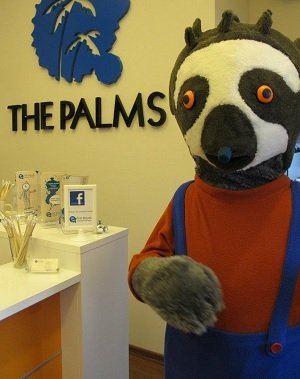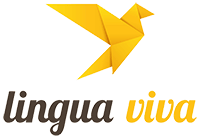Are you wondering if a language school can be a brand? Of course, if you continuously build its awareness and create a desired image. It is a time-consuming process, but it’s worthwhile.
Just think, would you buy a product from a store you’ve never heard of, or from the one with that funny animal in the logo? Exactly… today, we provide tips on how to build branding for your language school.

What will you find in this article?
- What is branding in a language school?
- How to create the image of a language school?
- What is a brand hero and why is it worth creating one?
- When is it time for a rebranding?
- Summary – the image of a language school
What is branding in a language school?
Just as you would go to a store you already know, your students are more inclined to enroll in a school they recognize and associate with positive emotions.
A brand is not just a product – it’s a unique story that you freely create.
To gain loyal customers, you must undertake marketing activities that will distinguish your language school from the competition.
But let’s start with the basics and the definition of branding.
Branding is the process of creating and managing a brand image. In the case of language schools, this means building an identity that will allow you to stand out from the competition.
It’s everything that makes your school easily recognizable, appreciated, and remembered by students and their families.
Elements that constitute the image of a language school
- Logo and visual Identity. Consistent colors, fonts, and graphic style are fundamental. Choose visual elements that will be easily recognizable and associated with your school’s mission. It may be worth considering the help of a professional graphic designer in this case.
- Name and slogan. They should clearly reflect the mission of your school. A slogan can be a short call to action that emphasizes the uniqueness of your offer, for example, „We teach more than just the language – discover the Spanish soul!” (for a language school that also focuses on cultural learning) or „We turn words into success!” (for a language school offering business courses).
- Communication language that will match your target audience. Are you communicating formally or casually? For instance, if your target audience consists of children and their parents, use a friendly, easy-to-understand language.
- Customer experience. How do students perceive your services? This affects their opinions and recommendations. Ensure an intuitive enrollment process, availability of educational materials online, and quick contact with customer service. Read more about Customer Journey Map in a language school!
- Educational offer. Unique courses, learning methods, and additional services that will distinguish your offer. An example could be a course in specialized business language or conversation classes with native speakers.
- Social media, which will help you build engagement. Regular publications, interactions with users, and engaging content such as language quizzes or class reports strengthen the image of your school.
Read the article where we suggest how to create a good language school logo!
How to build the image of a language school? Step-by-step strategy development.
A strong brand is not just a logo and name – it’s the emotions, values, and unique promise you deliver to your students. First, you must consider your target audience. The image of a language school should reflect the needs of your audience.
To begin efforts to strengthen your brand image, you should develop a Brand Book, which serves as a guide for visual communication with clients or business partners.
What does such a book contain? It usually consists of three parts, which we have discussed below.
Company presentation
Start by writing about what you do, what your goals are, and what vision and mission guide your activities. The idea is to understand what your school is and where it is heading.
Visual identity
In this section, design:
- the name,
- color scheme,
- typography (distinctive fonts),
- logotype (also known as logo, brand mark),
- claim (brand slogan).
Remember to include guidelines on how to use these elements and how not to use them. See more in the article: visual identity of a language school.
Usage history
List practical ways of using visual identification, that is, what media you have used so far and what communication techniques you have applied (e.g., Internet, flyers).
The most important thing is that all elements of the strategy are consistent with each other. If you have a green logo, you shouldn’t design business cards in pink. This is, of course, an exaggerated example, but it emphasizes how clients might perceive us.
Visualization is not the only thing we should focus on. It’s extremely important what your brand says and how it behaves. Remember that every email sent, website, and even social media messages should have consistent communication.
REMEMBER!
By building a strong brand and a consistent image for your language school, you will gain:
✔︎ greater trust – professional branding inspires greater trust among potential students.
✔︎ higher prices – a strong brand allows you to compete on quality, not price.
✔︎ greater loyalty – clients are more likely to return to schools they are familiar with.
✔︎ more effective promotion – your school will be more easily remembered and recommended.
What is a brand hero and why is it worth creating one?
Today’s customer is inundated with advertisements for products and services, making it difficult to stand out in the market. A brand hero comes to the rescue. It’s nothing more than a brand mascot, a hero serving as your living business card.
When a customer buys a book, they usually look at the review on the back cover without reading the whole thing. What will you do to make a potential student choose your language school? Offer them more than just a product – emotions.
The values and personality of the brand should be reflected in the created character. What characteristics should it have, what attributes, where and with whom will it appear? It all depends on the story you want to tell and the emotions you want to evoke in your audience.
The hero of your language school could be an animal, a person, or an abstract character; the only limit is your imagination.
 | An example could be SMOK SJOk — where “Smok” means “dragon” in Polish — affectionately known as the friend of Foreign Language Study. SMOK SJOk accompanies the youngest learners during classes and outdoor events. He is kind, funny, and most importantly, designed in consistent colors that match the school’s website and logo. |
| A very friendly brand hero is Strefek, who has found a home in Strefa Języka. The creature appears everywhere, advertises events on Facebook, and positively associates with the school, matching its colors. His hobbies are „learning languages, playing with children, games, dancing, and jumping,” which naturally ties into teaching children. |  |
 | The language school The Palms also has its mascot. Akiki (in Malagasy means „friend”) is part of the complete image identification of the school: the name, corporate identity, references to roots in Madagascar, pro bono activities, and the entire proprietary program. The lemur helps children learn English and additionally brings a lot of joy. Akiki also has a family and exists in the form of a handmade mascot that children recognize from classes. |
Perhaps it’s time for a rebranding?
If you’ve noticed a decline in your brand’s value, new competition has appeared, you haven’t had new students for a long time, or you’re targeting a new group of clients, it’s time for a change.
Rebranding is essentially the renewal of an image, the modification of all elements identifying the language school. This naturally involves changing the entire marketing strategy, so it is a time-consuming and costly process.
IMPORTANT!
Rebranding is not just changing a logo or color scheme; it is primarily a new value proposition you make to your students.
A few years ago, the language school LinguaViva decided to rebrand. The goal was to adapt to the current market demands, which led to a new logo, the creation of a new website, promotional materials—all under the watchful eyes of instructors, random clients, and the owner. The refreshed image was well received.
| Previous | Current |
 |  |
Summary – the image of a language school
So is it worth building a positive image? Definitely! A strong brand translates to sales. Not only do you stand out in the market, create an advantage over the competition, and increase the financial value of your school, but you also attract new clients.
Building an image is an investment that pays off over the years. However, remember that branding is not just about aesthetics, but most importantly about the relationships you build with your students. Ensure that they always think of your school in a positive way.
Check out our articles, which will be a good supplement to this article:
✔︎ how to measure and improve customer satisfaction in a language school?
✔︎ how to gain student loyalty in a language school?
